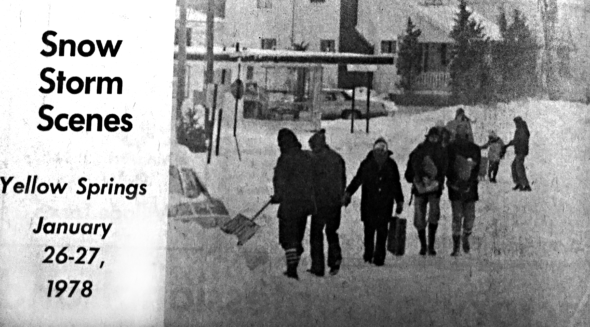
The end of January marks 40 years since the worst snow storm in Yellow Springs — and Ohio — history.
Way Back Wednesday — The Blizzard of 1978
- Published: January 31, 2018
On the front page of the Wednesday, Jan. 25, 1978 issue of the Yellow Springs News, the top headline reads: “Snow news is good news.” Editor Don Wallis writes briefly about village efforts to clean up streets and driveways from the large amount of snow that has accumulated over the past weeks of deep winter. Featured on the front page are young villagers who have taken advantage of the increased snowfall to hone their architectural and construction skills.

The paper’s caption for these photos reads: “ESKIMO weather demands Eskimo shelter, so four Yellow Springs youngsters built an igloo last week. Making snow bricks formed in milk carton molds, these snowfolks fashioned a cozy dwelling big enough for two (plus, with a bit of squeezing, New photographer Bill McCuddy). In photo at bottom right, posing with their igloo are (left to right) Spike Peyroux, Michael Young, Lisa Love and Jon Kadish. At left, peeking from outside in at the camera lens, are (clockwise) Jon, Spike and Michael, with Lisa partially obscured in background. And settling in with a bedroll and a radio are Michael Young and Spike Peyroux. The clever project took about a week to complete.”
After extolling the virtues of village workers and villagers alike in helping to clear the snow, Wallis muses, ‘What this winter seems to have next in store is rain and warmer temperatures.”
On Thursday, Jan. 26, 1978 — the day after the above issue had gone to print and ostensibly been delivered — the worst and deadliest storm in 100 years of weather records hit the state of Ohio. Snow fell continuously and high wind gusts — reported at 70 miles per hour at the highest in the Miami Valley and as high as 86 miles per hour near Lake Erie — created dangerous snow drifts. Impassable roads, failing electricity and lack of food, water and heat created an emergency situation as municipal function came to a stand-still around the state. After all was said and done, 51 deaths were reported state-wide.
In Yellow Springs, however, a different image emerged at storm’s end. On the front page of the Feb. 1, 1978 issue of the News, editor Don Wallis again began to praise villagers and Village workers alike, writing in great detail about the many ways in which the community had worked together in order to come out of the blizzard unscathed. According to Wallis’ editorial for the week, the village manager, assistant village manager and fire chief were all bed-ridden due to illness during the storm, and two of three township trustees were out of town, so it was something of a miracle that there was no lasting damage from the storm. As Police Chief Jim McKee is quoted as saying, “We had a lot of good luck.” In his editorial, Wallis adds: “Maybe so, but good luck is more often earned than freely given, and nobody will ever know what might have happened — death, injury, illness, destruction — if so many people hadn’t worked so hard and so well for so long in the midst of the worst weather we’re likely to see for a while. Thanks, folks, for that.”
Below is the text of Wallis’ full front page report (with some photos) on the blizzard and the near-misses that villagers lived through during the worst of it.
_________
Feb. 1, 1978
The worst winter storm in its history hit Yellow Springs last week, but the village took the siege in stride.
Despite bone-cold temperatures, cruelly strong winds and snow piled high all over in town, Yellow Springs somehow survived last week’s blizzard with little more than extensive inconvenience.
It was, as more than a few folks commented, something of a minor miracle: despite all the potential for a major disaster, no disaster occurred. As police chief Jim McKee put it: “We knew we had a crisis on our hands, and for three days we worried and worried. But in the end, nothing we worried about happened.”
The worries were elemental — about warmth and shelter and food, water and fire, illness and death. Specifically, Village officials were concerned about these possibilities:
•That persons might be trapped in heatless homes by the high-piled snow.
• That the Village water system might fail, as it did almost exactly a year ago and in similar circumstances.
• That fire might break out in an area made inaccessible to firemen by snow, or when water supplies were inadequate to fight the blaze.
• That persons needing medication or medical treatment might be snow-prevented from getting it.
• That motorists or pedestrians might get trapped in the incredibly strong-drifting snow that plagued most sections of town for two days and nights.
But thanks to some extraordinary work by many, many people — and a healthy portion of good luck — none of these worries materialized.
People were trapped, but were rescued.
The water system almost did fail, but it was salvaged.
There was a fire, but it was quickly contained.
People did need medical help, but they managed to get it.
And when the last of the monstrous snow drifts was cleared away, no victims were found.
“We were,” says Village Manager Bruce Rickenbach, “very, very fortunate.”
Police Chief McKee adds: “We also had a whole lot of people who worked very hard and very well. People volunteered to help. Neighbors helped out neighbors. I’m proud of the way the Village workers performed — but most of all, it was great to see the community pull together the way it did. If it hadn’t been for that, we could have had a real tragedy.”
*
The stage for a “real tragedy” was set Wednesday evening. With about 14 or 15 inches of snow already on the Yellow Springs ground, more snow began to fall. By dawn Thursday, 10 more inches was added.
But what really mattered was the wind.
Averaging a vicious velocity of 40 to 50 miles per hour and gusting up to 70 miles per hour, the wind howled, beat against windowpanes, wrecked the limbs of trees — and swirled the snow all over town.
It was soon obvious that the storm was creating a major emergency. Officials started organizing the perform four basic tasks: evacuation of families from their homes; fire control; maintenance of electricity and water service; snow removal. Taking these tasks one by one:

Evacuation. Some people were trapped by the snow in houses left heatless by failures that plagued the Village’s electric system, primarily in the south end of town but also in the northern sector. Additionally, some homes had electricity failures of their own, unrelated to the Village system’s problems.
But these people were evacuated without much difficulty. Four-wheel drive vehicles, snow plows and human power were used. All the “refugees” found temporary shelter with friends or relatives or neighbors. Shelter centers were set up hastily in the Village Building and the Methodist Church, but they weren’t used.
More serious emergency situations existed for people needing medication or medical treatment. Perhaps the closest call involved a 10-month-old baby in a home in a rural area near Bryan Park — not all that accessible in the best of weather, and very hard to reach with all the snow. At about 6 p.m. Friday, the baby suffered from a temperature of 103 degrees and was experiencing convulsions — and was totally snowed in.
But the baby was rescued, by Yellow Springs Fire Department volunteers and Life Squad workers. They used snow plows to dig their way into the area near the home — then went the rest of the way to the house on foot, lugging assistant fire chief Dave Hillman’s toboggan. The baby was loaded onto the sled, gently eased out to the Life Squad ambulance and brought to town for treatment. He’s doing fine.
Two other sick children were trapped, but were helped out for care by doctors, who were themselves transported by four-wheel drive through the snow to their offices. Workers helped druggists Carl and Bud Johnson get into their medication supplies so they could dispense them to folks needing them — one of those being a man who required an insulin injection, but was snowed-in along with 90 fellow employees at Vernay Laboratories Thursday morning. He got his shot.
The evacuations were conducted by the Village police staff, other Village workers, by firemen and Life Squad workers, by snow plow drivers and volunteer citizens — and by all kinds of combinations of these, working together as teams. The goal was to link up victims of the storm with the help they needed — shelter, medicine or doctors.
And in all cases, the evacuations were successful. “All things considered,” says assistant fire chief Hillman, “things went as smoothly as we could have hoped for.”
*
Fire control. The blizzard posed multiple problems for Yellow Springs firemen. Whole areas were totally inaccessible. Key streets were blocked, either by snow or by fallen trees and tree limbs. The Village water tank supply fell, and the whole water system was threatened, by an electricity power outage (more on that later). On top of this, the excruciating cold prompted many people to overload their heating systems or to improvise new ones to replace systems knocked out by the power outage — such as wood stoves, fireplaces, even kerosene stoves — and thus increase chances for a fire.
Faced with all these difficulties, the firemen really couldn’t do much. If a major fire had broken out, chances are they wouldn’t have been able to get to it — and if they could have gotten to it, chances are they wouldn’t have had enough water. And with roads to Yellow Springs impassable or nearly so, assistance from area fire units — including bringing in needed supplies of water — was unlikely.
There was one thing the firemen could, and did, do. They “roamed” the Village in four-wheel drive vehicles — looking, as it were, for trouble. The idea was to spot potential fire situations before they developed, to get people out in the town for hopefully quick access to a fire should one break out, and in the process to make some “trails” through Village streets for others to use.
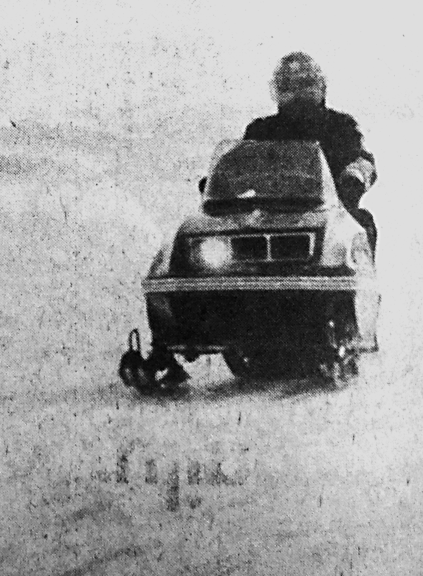
An unnamed villager cruises in a snowmobile.
It was a good thing they “roamed.” At about 7 o’clock Thursday evening, a fireplace on Meadow Lane overheated, burned through firebrick and into the wall behind and above it. With incredible good fortune, a team of firemen was “roaming” around Meadow Lane. “They were,” said assistant fire chief Hillman, “literally right around the corner.”
So in something like 10 seconds after the fire call came in, firemen were on the scene. In about two minutes, others arrived, enough to start working on the fire — which was extinguished a few minutes later.
“If we had gotten there, say, in 10 minutes, which would have been pretty fast in normal circumstances, that fire might have been too big for us to handle,” says Hillman. As it was, damage was limited to about $500 worth — and nobody got hurt.
And that was the only fire scare during the blizzard.
*
Electricity and water. The lethal winds that began whipping up Wednesday night took their local toll Thursday morning. They either blew some power lines together, or blew lines against trees — in any event, fuses were blown and power was lost to the south end of the village and to the north end of the village at about 3:22 Thursday morning.
That’s was required most of the evacuations — without electricity, heating systems don’t function. As some Village workers tried to restore power, others helped heatless families find warm shelter. At 10:40 in the morning, power to the north end of town was restored — but power remained out in the south end.
Shortly after that, a bigger worry surfaced. At 11:48 a.m., Village workers learned that the town’s water plant wasn’t functioning. With the electricity out, an automatic pump set to keep the water in the water tank at a safe level didn’t kick on — and the level had fallen to 20 feet, 19 feet below normal. Explains Village Manager Rickenbach:
“That meant three things. First, with the tank level low, pressure throughout the system was getting low. Second, we had an inadequate supply of water on hand to fight a major fire, if one had broken out. Third, we felt it was possible that with the water so low, the overall weight of the tank would be lessened so much that those 70-mile-an-hour winds could blow it over.”
The first order of business was to check out the water plant. To do that, though, workers had to burrow themselves through massive snow piles into the plant. Meanwhile, workers had gotten the Yellow Springs electric system back on line — at 3:30 Thursday afternoon, power to the south end was restored.
But the power went out again 19 minutes later, at 3:54.
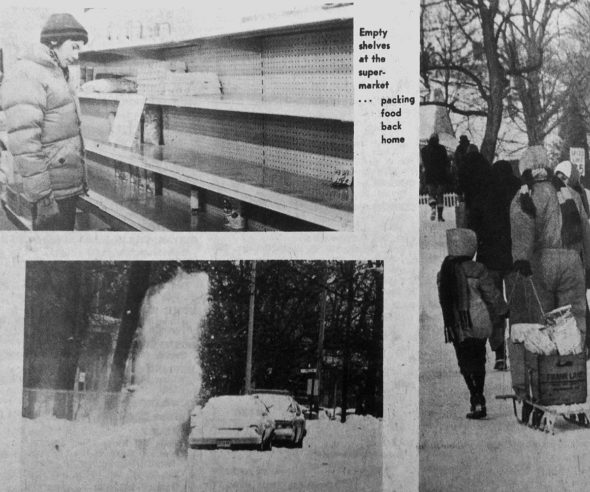
Rickenbach again: “What happened was this. When the power went out, it was at a certain demand level — and that level of demand had built up gradually over a period of time. When it was restored, the whole demand was made all at once. It was too much load for the system, and the fuses blew again.”
Luckily — and thanks to last year’s winter storm disaster — there was a way out of the dilemma. A year ago, after much the same problem had occurred, the Village installed a switch connecting the Yellow Springs electric system directly with Dayton Power and LIght’s system.
That switch was located behind a massive mess of snow near the Morris Bean plant. Village workers began fighting their way into it, and by 8:22 p.m. they had hooked the water plant up to Dayton Power and Light — and the water system was revived. The level in the water tank began to rise, and that particular disaster was averted.
With the water plant’s power load taken off the Yellow Springs system, it was adequate to feed electricity to the homes in the south end — and so when power was restored for the second time, at 9:45 p.m., it stayed restored.
The water system was working, and homes were warm again. Both stayed that way.
*
Snow removal. Two problems here: too much snow, too much wind. The snow as hard to move in the first place — and after it was moved, the wind would blow it back again.
The biggest problem was at the south edge of town, where a drift 15 feet high closed down Xenia Avenue at Allen Street Thursday and Friday. Volunteer fireman Todd Van Lehn managed to move enough snow with a front-loader to open the road — only to see the winds cruelly blow it back and close again.
And that’s how snow removal went.
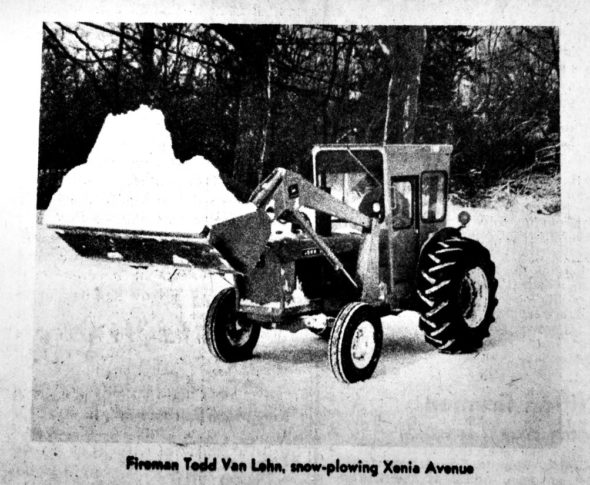
Dayton Street was closed for a short time at the western edge of town, where the biggest drift of all was created on Enon Road, near the middle school-high school campus. That drift was unmoved until Saturday, when special snow-blowing equipment from Wright-Patterson Air Force Base conquered it. It was the last drift to be defeated.
“On top of everything else,” recalls police chief Jim McKee, “we all were worried that when we finally got that big drift moved, we’d find a car under there with a body inside. We almost dreaded moving that drift.” But when the drift was moved, there was nothing there on Enon Road.
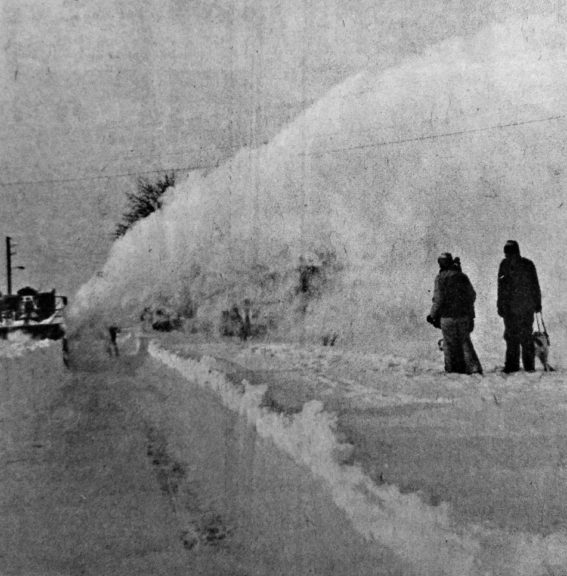
A heavy duty snow remover on loan from Wright-Patterson Air Force Base removes the village’s largest snow drift along Enon Road.
And that seemed to serve as a fitting close to the worst winter storm in Yellow Springs history. The Village was the winner: No deaths, no injuries, not even any more than minor damage. What’s left are a lot of weary people, blizzard memories, and
all
that
snow.
—Don Wallis
2 Responses to “Way Back Wednesday — The Blizzard of 1978”
The Yellow Springs News encourages respectful discussion of this article.
You must login to post a comment.
Don't have a login? Register for a free YSNews.com account.













Heard all about it, but actually missed the event as I had left for Florida the day before the Blizzard hit and came home sporting a smile and tan. Some asked “What did you do?” as if I’d somehow provoked the event. I assure you, I did not. XO Peace
Spike Peyroux. Wow is that a blast from the past! I remember the blizzard of 78 well. Chris Blakeman, Strider Jordan, and I made some massive snow forts in the plowed snow mounds along Corry Street. Great memories.